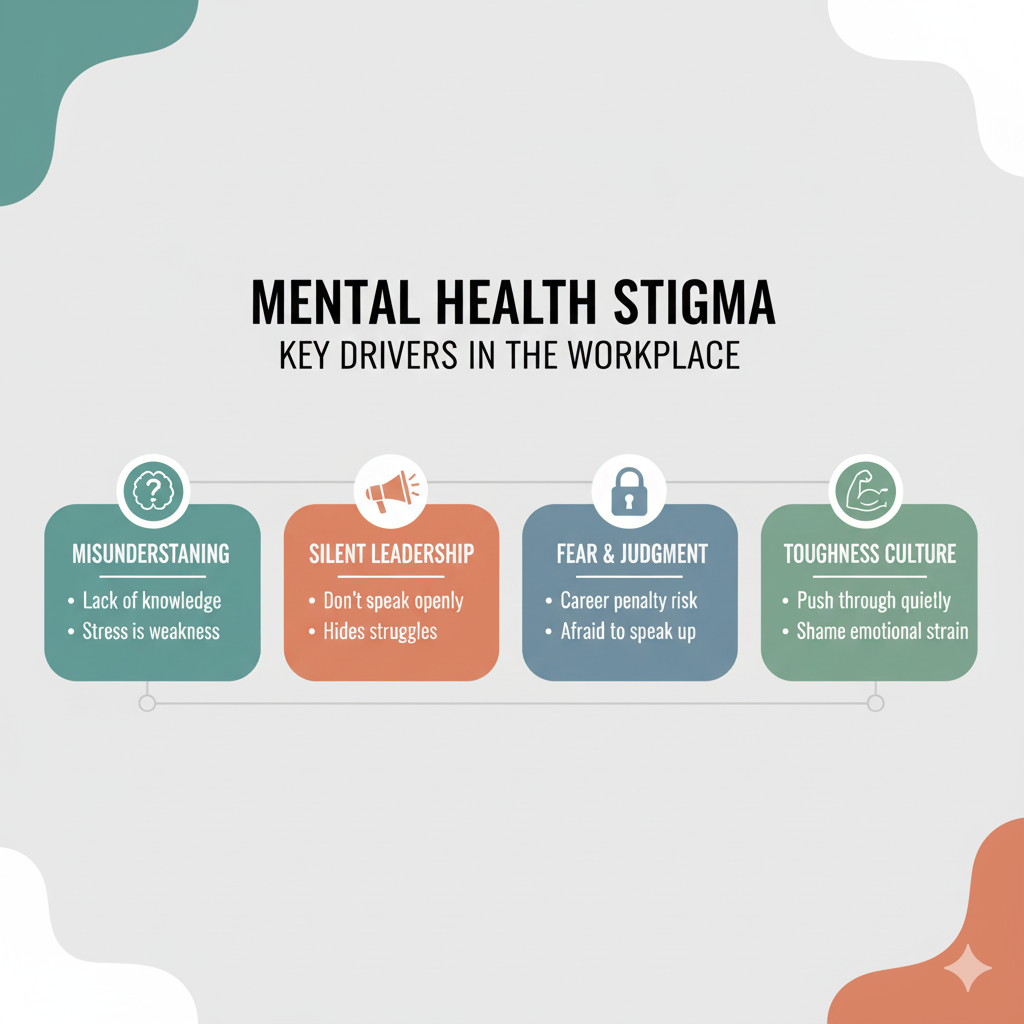Picture an employee who feels overwhelmed but remains silent at work. They may fear being judged. They may worry that speaking up will make others see them as weak or incapable. Many employees experience this. Mental health stigma in the workplace creates an environment where people hide their stress, anxiety, or emotional concerns. It discourages open conversations and prevents individuals from accessing the support they need.
Mental health stigma in the workplace refers to negative attitudes or assumptions about people who experience mental health challenges. This can show up in subtle ways. People may dismiss emotional strain as a personal flaw. Teams may avoid discussing psychological well-being at all. This silence can create further stress and isolation.
The impact of stigma is serious. Anxiety and depression lead to about 12 billion lost workdays every year, which costs businesses close to $1 trillion in productivity losses worldwide, based on findings shared by the World Health Organization. When employees feel unable to seek help, work performance declines. Absenteeism rises, and turnover can increase.
This blog will explore why reducing mental health stigma in the workplace matters. It will also outline the key causes of stigma and provide practical strategies that leaders can adopt. The goal is to support workplace mental health awareness and encourage a culture where people feel safe to express their needs.
Why Mental Health Stigma in the Workplace Matters
Reducing stigma requires awareness. By examining how stigma affects people and organisational culture, workplaces can create healthier and more supportive environments.
Impact on Employee Well-Being
Mental health stigma in the workplace affects how people feel about sharing their stress or emotional challenges. An employee who is struggling may stay silent because they worry others will judge them. This silence can increase feelings of pressure and isolation. When support is viewed as unacceptable or unavailable, mental health concerns can slowly grow more serious. Employees may begin to feel overwhelmed and disconnected.
Effect on Productivity and Performance
Stigma can influence performance at work. Employees may experience low motivation, exhaustion, or difficulty concentrating. They may feel present at work but unable to fully engage. This is sometimes referred to as presenteeism. Research shared through NCBI notes that many employees choose not to speak about their mental health concerns due to fear of negative reactions or discrimination. This lack of openness can delay early support and increase strain.
Financial and Operational Costs
There are financial consequences for organisations. Findings referenced by Kaiser Permanente show that untreated mental health conditions and stigma contribute to large economic losses. Reduced productivity, increased sick leave, and high turnover are common outcomes. Businesses may also experience higher healthcare-related expenses. When stigma remains, these issues continue and can weaken the organisation’s long-term stability.
Effects on Workplace Culture
Stigma also influences workplace culture. When employees feel unsafe speaking about mental health, communication becomes limited. This creates emotional distance between colleagues and leadership. Trust can weaken. A supportive culture encourages open and respectful conversations. It helps people feel understood and valued. When organisations take steps to reduce stigma, relationships improve and teams become stronger.
If organisations want to reduce mental health stigma in the workplace, they must first acknowledge how deeply it influences employee experience and performance. A workplace that supports emotional well-being is more likely to build strong relationships and long-term commitment.
Key Drivers of Mental Health Stigma in the Workplace
Mental health stigma does not appear by accident. It develops from beliefs, behaviours, and workplace norms. Understanding these drivers helps organisations take meaningful steps toward change.

Low Mental Health Literacy and Misunderstanding
Mental health stigma in the workplace often begins with misunderstanding. Some employees still view emotional stress as a sign of weakness. When people believe they must stay strong at all times, they may hide what they are experiencing. This makes open conversations difficult. It has been found in many studies that limited mental health literacy leads to silence, assumptions, and fear.
Silence from Leadership and Lack of Communication
Leadership behaviour shapes workplace culture. When leaders do not speak about mental well-being, employees may assume the topic is not appropriate to discuss. Silence can suggest that mental health struggles should remain private. This creates emotional distance between managers and their teams and reduces trust.
Fear of Judgement and Career Penalty
Many employees worry that openly discussing stress or anxiety could affect their job stability or growth. Concerns about performance reviews or promotions can stop people from seeking help. Various researches show that employees often hold back due to fear of being judged or misunderstood.
Cultural Norms That Reward Toughness
Some workplaces have an unspoken rule to push through challenges quietly. This can make people feel isolated. It also discourages honest conversations. A supportive culture is one where individuals can talk about emotional strain without shame.
Building workplace mental health awareness begins with recognising these drivers. By understanding them, organisations can start to reduce mental health stigma in the workplace and create safer and healthier environments.
Evidence-Based Strategies to Reduce Stigma
Reducing mental health stigma in the workplace requires steady and long-term action. It is not solved by a single policy or training session. Support must become part of daily work culture. The following approaches help organisations build trust, safety, and genuine care.
Leadership Visibility and Mental Health Advocacy
Leaders shape what is acceptable to talk about at work. When leaders acknowledge stress and emotional challenges, they make it easier for others to do the same. Speaking openly does not require sharing personal details. It can be as simple as checking in during meetings, sharing reminders about support resources, or stating that mental health matters in the organisation.
Research shared in the McKinsey report on better workplace mental health shows that visible leadership support encourages employees to seek help earlier. When leaders model openness, employees feel less alone and more willing to access care. This approach supports trust and reduces silence.
Training, Education and Literacy Programs
Many employees do not seek support because they do not know how to describe what they are feeling. Others may hold misconceptions about mental health coaching or therapy. Training can change this. Workshops, short learning sessions, and mental health first-aid programs help people understand common emotional challenges.
However, many findings suggest that education reduces assumptions and builds empathy. Training also provides language that makes conversations easier. When people have words to express their experiences, stigma begins to soften. This improves workplace mental health awareness and confidence in offering support.
Confidential Support and Easy Access to Care
Employees need a safe way to seek help. Support should be confidential, judgment-free, and easy to access. This may include Employee Assistance Programs (EAPs), mental health coverage, counseling services, or digital well-being tools.
A digital mental health companion like Yuna can offer daily support through reflection prompts, guided exercises, and coping strategies. It helps employees check in with themselves in private. This reduces fear of being observed or judged and encourages consistent care. It is also found that when people trust that support is confidential, they are more likely to use it.
Measure, Monitor and Embed Culture Change
Improving culture requires ongoing attention. Organisations can track progress through employee surveys, feedback discussions, usage rates of support services, and engagement indicators. These insights show where change is working and where more support is needed.
Over time, recognising positive change, acknowledging efforts, and celebrating openness helps build shared commitment. This turns mental health support into a normal part of workplace life, not a special initiative.
A stigma-free workplace develops through small actions repeated consistently. With steady leadership, education, confidential tools, and ongoing evaluation, organisations can begin to reduce mental health stigma at work and support healthier employee experiences.

What are the Best Practices for Reducing Mental Health Stigma in the Workplace?
Many workplaces want to support emotional well-being, but the approach must be steady and realistic. These practices work best when they are part of daily habits rather than one large initiative. The idea is to build a work environment where employees feel respected and heard.
Encourage Regular Check-ins
Regular check-ins help create space for honest moments. Managers can ask simple questions about employee well-being during one-on-one discussions or small team talks. This shows care without causing pressure. When these conversations happen consistently, trust becomes stronger. Employees begin to feel seen, supported, and accepted.
Provide Easy Access to Support Tools
Access to support must be clear and uncomplicated. Workplaces can introduce counseling partners, internal support leads, or digital mental health companions. Yuna can be one of these tools. It offers quiet daily reflection and emotional grounding in a private space. When support is easy to reach, more people feel comfortable using it.
Normalize Everyday Conversations About Mental Health
Small mentions of emotional well-being in newsletters, workshops, or training can shift a culture. When mental health becomes a natural part of daily communication, it no longer feels hidden. Employees learn that discussing stress or emotional challenges is normal and welcome in the workplace.
Respect Healthy Boundaries and Breaks
Supporting boundaries shows respect for personal capacity. Encouraging employees to take breaks, pause during stressful moments, and step back when needed helps protect emotional balance. When time off is honored, trust in the workplace increases. This sets the tone for a supportive environment.
What are the Metrics to Track Progress?
These practices need consistent observation to see whether they are working. Tracking progress helps leadership understand what is improving and what needs more support. It also guides communication and planning so the workplace continues to grow stronger.
Employee Survey Insights
Short and regular surveys can show how comfortable employees feel discussing emotional stress. They can also reveal whether trust in leadership and team support is rising. These surveys do not need to be complex. What matters is consistency and clarity.
Usage of Support Services
Tracking the use of available mental health support shows whether people feel safe seeking help. This includes Employee Assistance Programs, counseling partners, and digital companions like Yuna. When usage increases, it may indicate that stigma is decreasing and comfort is growing.
Patterns in Absenteeism and Presenteeism
Changes in attendance patterns can provide useful signals. If emotional support increases, absenteeism or silent productivity struggles may decrease. This helps leadership understand the real impact of workplace well-being practices.
Retention and Feedback Patterns
Employee retention rates often improve when employees feel understood and respected. Feedback during team conversations or check-ins can also show what is working. Employees may share what helps them feel supported and what still feels difficult. These insights guide continuous improvement.

Workplace Well-Being Support with Yuna
Yuna can act as a daily mental health companion for employees. It provides quiet space to reflect, understand feelings, and calm the mind. Employees use it privately at their own pace. This supports emotional balance during work and beyond.
Employers can also add Yuna to existing wellness programs easily without requiring large training. It fits into daily routines and strengthens a culture of openness and care.
FAQs
What is mental health stigma in the workplace?
Mental health stigma in the workplace refers to negative assumptions or discomfort around discussing emotional stress. It can prevent employees from asking for help. Reducing stigma creates a safer and more supportive work environment.
How can employers reduce mental health stigma?
Employers can reduce stigma by encouraging open conversations, offering easy access to support tools, and respecting healthy work boundaries. Consistent check-ins and steady communication help employees feel supported and accepted.
Why is it important to talk about mental health at work?
Talking about mental health at work helps employees feel understood and valued. It supports emotional balance, improves teamwork, and reduces silent stress. Open discussion also promotes trust between leaders and teams.
How can digital tools like Yuna help?
Digital mental health companions like Yuna provide private reflection and guided emotional support. Employees can use them daily without pressure. This makes mental health care accessible, steady, and easy to practice during busy routines.
What are signs of a supportive workplace culture?
A supportive workplace culture encourages regular breaks, open conversations, and fair workloads. Employees feel safe expressing concerns. Leadership communicates clearly and shows care in daily interactions, not only during formal wellness programs.






